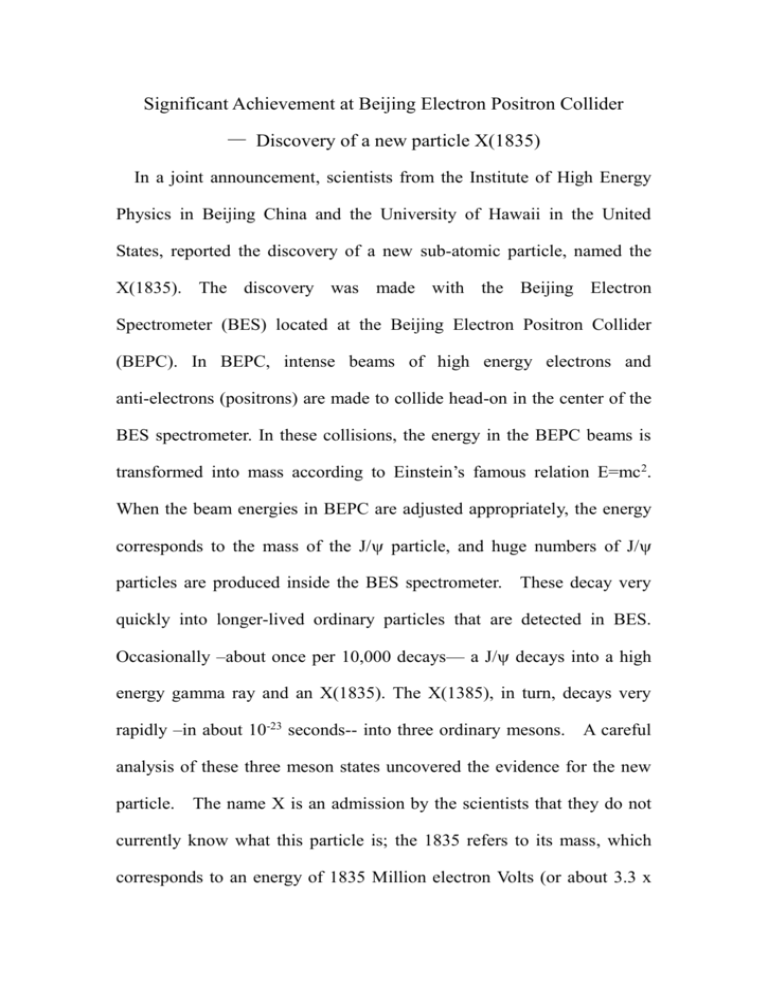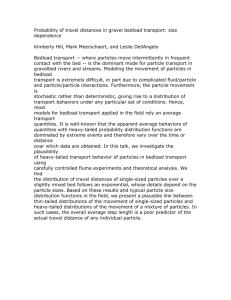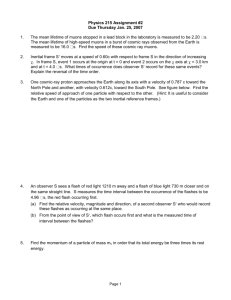Significant Achievement at Beijing electron positron Collider
advertisement

Significant Achievement at Beijing Electron Positron Collider — Discovery of a new particle X(1835) In a joint announcement, scientists from the Institute of High Energy Physics in Beijing China and the University of Hawaii in the United States, reported the discovery of a new sub-atomic particle, named the X(1835). The discovery was made with the Beijing Electron Spectrometer (BES) located at the Beijing Electron Positron Collider (BEPC). In BEPC, intense beams of high energy electrons and anti-electrons (positrons) are made to collide head-on in the center of the BES spectrometer. In these collisions, the energy in the BEPC beams is transformed into mass according to Einstein’s famous relation E=mc 2. When the beam energies in BEPC are adjusted appropriately, the energy corresponds to the mass of the J/ particle, and huge numbers of J/ particles are produced inside the BES spectrometer. These decay very quickly into longer-lived ordinary particles that are detected in BES. Occasionally –about once per 10,000 decays— a J/ decays into a high energy gamma ray and an X(1835). The X(1385), in turn, decays very rapidly –in about 10-23 seconds-- into three ordinary mesons. A careful analysis of these three meson states uncovered the evidence for the new particle. The name X is an admission by the scientists that they do not currently know what this particle is; the 1835 refers to its mass, which corresponds to an energy of 1835 Million electron Volts (or about 3.3 x 10-24 gram), which is slightly less than twice the mass of proton. This result was just published in the world famous journal Physics Review Letters. The X(1835) has received considerable attention from the international high energy physics community, not just because it is another new particle, but because of the possibility that it may be a new type of particle, one that has been searched for by high energy experiments for over 30 years. So far, every one of the many known particles that experience the strong nuclear force are composed of either two or three quarks. Nevertheless, particle physicists have long predicted the existence of other types of particles, including: multi-quark states, which contain more than three quarks; glueball states, which are made of gluons (the carrier of strong force); and hybrid states, which are made of gluons and quarks. The experimental observations of any of these new types of particles would be an important verification of these ideas and help further the development of the fundamental theory of particle physics. A main physics goal of a number of experiments world-wide, including the BES experiment, is the discovery of such particles. An intriguing feature of the X(1835) is the fact that its properties (mass and lifetime) are consistent with those of another new particle found by BES two years ago in J/ decays into a high energy gamma ray plus a proton and an anti-proton. This remarkable consistency has led some physicists to speculate that these two observations are related and are, in fact, different aspects of the same particle; a particle that is formed from a proton and an anti-proton that are stuck tightly together (this would be a new kind particle made of six quarks). However, with the existing data, the possibility that the consistency between the properties of the two states is just a coincidence cannot be excluded. To really pin down the nature of the X(1835), more experimental and theoretical research is needed. More experimental data is especially needed. Among the many high energy particle accelerators around the world, the BES/BEPC facility is unique in that it is the world’s premier facility for producing and studying J/ particles. Since J/ decays are prolific sources of other particles, the unique capabilities of BES and BEPC have enabled scientists working there to produce many new and interesting scientific results. During the past few years, the BES collaboration, which is composed of many physicists from about 20 institutions from China, the University of Hawaii, and other countries, has published 60 papers in internationally renowned journals. These papers, especially those reporting on a series of new observations that are related to the search for multiple quark states, have kept Chinese particle physics research at the forefront of the high energy physics world. Currently, a major upgrade is being carried out for BEPC and BES. When the upgrade is complete in 2007, the BEPC particle production rate will be increased by a factor of 100, and the performance levels of the BES detector will be much improved. With the upgraded facility, there will be hundreds of times as many X(1835) particles to study and, with these, decisive conclusions about its underlying nature will be possible. In addition, thorough searches will result in many other new and interesting discoveries that will enhance our understanding of the basic constituents of nature. This work is strongly supported by the Chinese theoretical physics community. During the past two years, experimenters and theorists have held a number of joint seminars and workshops to discuss the BES observations. From these, numerous comments and suggestions have emerged. The discovery of the X(1835) was a direct result of ideas that were generated in these meetings. A continued strong collaboration between the experimental and theoretical communities, coupled with the greatly enhanced capabilities of the upgraded BES/BEPC facility bodes well for China’s future in this important field of research.









